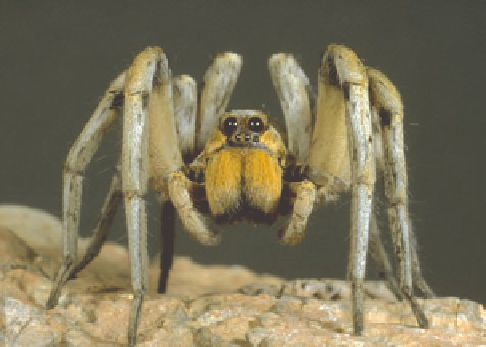Environmental Engineering Reference
In-Depth Information
who protect the soil, conserve water, reforest degraded
land, protect and restore wetlands, conserve wildlife,
and practice more sustainable agriculture and fishing.
Solutions
More Sustainable Aquaculture
• Reduce use of fishmeal as a feed to reduce
depletion of other fish
10-6 PROTECTING FOOD RESOURCES:
PEST MANAGEMENT
• Improve pollution management of aquaculture
wastes
Science: Natural Pest Control
Predators, parasites, and disease organisms found in
nature control populations of most pest species as part
of the earth's free ecological services.
A
pest
is any species that competes with us for food,
invades lawns and gardens, destroys wood in houses,
spreads disease, invades ecosystems, or is simply a
nuisance. Worldwide, only about 100 species of plants
(“weeds”), animals (mostly insects), fungi, and mi-
crobes (which can infect crop plants and livestock
animals) cause about 90% of the damage to the crops
we grow.
In natural ecosystems and many polyculture
agroecosystems,
natural enemies
(predators, parasites,
and disease organisms) control the populations of
about 98% of the potential pest species as part of the
earth's free ecological services. They help keep any
one species from taking over for very long.
For example, the world's 30,000 known species of
spiders, such as the wolf spider (Figure 10-26), kill far
more insects every year than insecticides do. As we
seek new ways to coexist with the insect rulers of the
planet, we would do well to keep spiders on our side.
When we clear forests and grasslands, plant mono-
culture crops, and douse fields with pesticides, we
upset many of these natural population checks and bal-
ances. Then we must devise ways to protect our mono-
culture crops, tree plantations, and lawns from insects
and other pests that nature once controlled at no charge.
• Reduce escape of aquaculture species into the wild
• Restrict location of fish farms to reduce loss of
mangrove forests and estuaries
• Farm some aquaculture species (such as salmon
and cobia) in deeply submerged cages to protect
them from wave action and predators and allow
dilution of wastes into the ocean
• Set up a system for certifying sustainable forms of
aquaculture
Figure 10-25
Solutions:
ways to make aquaculture more sus-
tainable and reduce its harmful environmental effects.
Critical
thinking: which two of these solutions do you believe are the
most important?
Agriculture is a financially risky business. Whether
farmers have a good year or a bad year depends on fac-
tors over which they have little control: weather, crop
prices, crop pests and diseases, interest rates, and the
global market. Because reliable food supplies are
needed despite fluctuations in these factors, most gov-
ernments provide assistance to farmers and consumers.
Governments use three main approaches to pro-
vide this assistance. One strategy is to use price con-
trols to
keep food prices artificially low.
Consumers are
happy, but farmers may not be able to make a living.
Another strategy is to
give farmers subsidies and tax
breaks to keep them in business and encourage them to in-
crease food production.
Globally, government price sup-
ports and other subsidies for agriculture total more
than $350 billion per year (about $100 billion per year
in the United States)—more than $666,000 per hour! If
government subsidies are too generous and the
weather is good, farmers may produce more food than
can be sold. The resulting surplus depresses food
prices, which reduces the financial incentive for farm-
ers in developing countries to increase domestic food
production—those connections again.
A third approach is to
eliminate most or all price con-
trols and subsidies and let farmers and fishers respond to
market demand without government interference.
Some an-
alysts urge that any phaseout of farm and fishery subsi-
dies should be coupled with increased aid for the poor
and the lower middle class, who would suffer the most
from any increase in food prices. Some environmental
scientists say that instead of eliminating all subsidies,
we should use them to reward farmers and ranchers
Figure 10-26
Natural capital:
Spiders are insects' worst ene-
mies. Most spiders, such as this ferocious-looking wolf spider,
do not harm humans.





